Centaurs and Centauromachy in the Greek world
Hybrid forms of human beings and beasts exist in the myths of different peoples and cultures throughout the centuries but the hybrid of man and horse, despite its adoption by the Romans and the Ortocid Turks , remained an element that constantly refers to Greek Mythology. The Greek Myth makes a distinction between the noble and divine origin of the Centaurus Chiron, who was the teacher of the heroes of Antiquity, and all the bestial human-horse hybrids that considered them appropriate only to be crushed by the illustrious heroes of Ancient Greece.
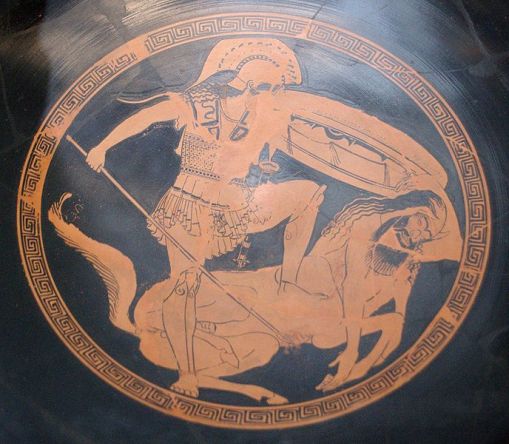
Theseus as centaurslayer. Source: http://www.madelinemiller.com
According to the famous French dictionary «Petit Larousse» (1920) the word «hybrid» (coming from the Greek word «hubris» that means insult) is used for words derived from two languages, such as cholera-morbus, bureaucratia but also for plants, or animals derived from two different species, such as the «hemionos», the mule. Hybrids are rarely fertile. The word «hubris» therefore means: «Sudden violence resulting from excessive sentiment of power or passion, indolence, arrogance, savagery, procrastination, frequently used in Homer’s Odyssey mostly on the suitors of Penelope. Also the «Papyrus – Larousse » encyclopedia (1963) goes even further by saying: Hybrid: (from the Greek » Hubris» in its usage for describing lewdness) Animal or plant derived from two different species of a subject. More specifically in biology, the term hybrid is also used for every biological structure, cell, gene, enzyme, DNA, derived from two corresponding structures, e.g. two cells containing different genetic material. «(Encyclopedia» Malliaris-Education «) And as we will see below, lewdness is interwoven with the myth of centaurs.
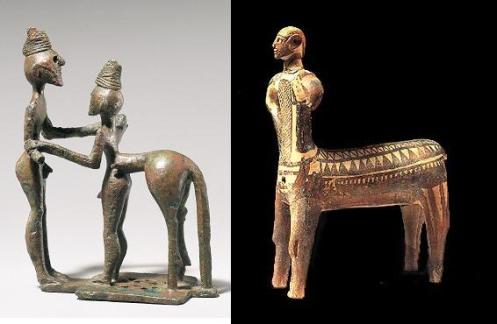
Statues of the Geometric Period that show the difference between Chiron and the other centaurs of Met. Museum New York (left) Museum of Eretria (right)
The Ancient Greeks believed that Centaur Chiron was born from the union of Cronus (Saturn) and the Nymph Phylira (Apollodorus.1.2.4). He was not a demigod then but a completely divine being. Unfortunately, he was born bizarre and abandoned by his mother, but he was given a god’s upbringing as Apollo and Artemis adopted him. Being properly raised, he undertook the training and education of the main heroes of Antiquity. He unfortunately became «collateral loss» of an arrow of Hercules, because of the savagery of the other Centaurs, and he voluntarily gave up his immortality in order not to suffer. Even from the Geometric period, the Greeks emphasized Chiron’s distinctiveness as a man with an attached horse body rather than a horse with a human extension like the other Centaurs. This type of depiction for Chiron continued until the Hellenistic Period.
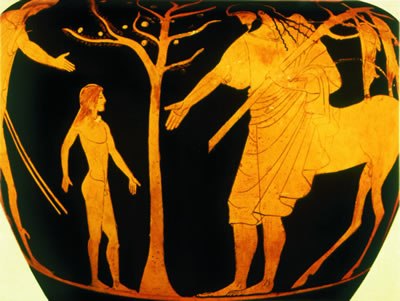
Peleus delivers Achilles to Chiron (Louvre G 186)
Although initially the trust that the Heroes’ fathers placed on a hybrid is strange to us, the Florentine political philosopher Nikolo Machiavelli explained the paradox by stating: «There are two ways to fight» through employment of the law and through usage of raw strength. The first way is fit for the humans and the second one for the beasts. But since the first way is inadequate, it is often necessary to resort to the second. That is why the prince needs to know how to use both ways both human and brutal. The writers of antiquity taught this lesson allegorically when they narrated how Achilles and many other ancient princes were sent to by taught by Chiron the Centaur. Having as a teacher a creature half a human and a half beast means that one learns how to use the one and the other nature, and that one cannot last without the other. »
The myths about the other Centaurs, if examined carefully, show the absolute difference of their nature with that of Chiron. The ancestor of the centaurs was Ixion, the lord of the Lapiths. He married the daughter of Hyoneas, and because he could not pay the dowry, he simply solved the problem by killing his father-in-law. As he was the first person ever to assassinate a relative, no mortal was willing to purify him from the abominable act, and he was living cast out from society. Zeus (Jupiter) took pity of him and invited him to Olympus to absolve him from the abominable act. And Ixion from his very … gratitude (sic) tried to seduce the goddess Hera! The god who realized his intentions created a cloud in the form of his wife, and Ixion was boasting after afterwards that he had mated with the wife of Zeus. The angered Ruler of Olympus condemned him to rotate eternally nailed upon a wheel. (Pindar, Odes 2.20)
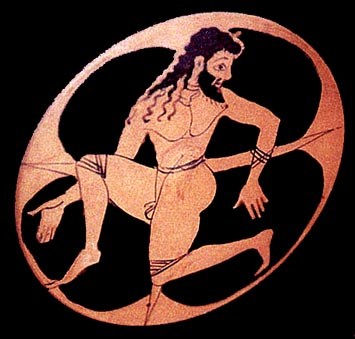
Ixion’s punishment. source: athenasweb.com
The living cloud in Hera’s form was called Nefeli, gave birth from Ixion’s semen a repugnant child, the first Centaur, who also lived as a social outcast. So when he grew up, he mated with the mares of Magnesia, and this bestiality produced the human-horse hybrid centaurs that we know from myth and art. (Apollodorus.5.1.20)
The Greek Myth does not mention anything positive about human-horse hybrids. They were sneaky assassins, as mentioned in the myth of Peleus, rescued by Chiron (Apollodorus 3.13.3) and even bigger drunkards. Their lust for wine undiluted by water – «unmixed wine» – made them attack Hercules (Apollodorus-5.1.20) and was also the cause of death of the wise Chiron (Apollodorus 2.5.4, Pausanias 5.19.9). Due to their uncontrollable wine drinking when they were invited to the marriage of the king of Lapiths, Peirithos, they attempted to rape the bride. (Apollodorus 2.3.1)
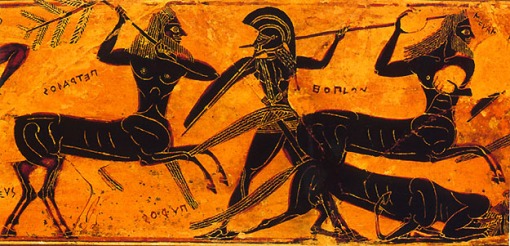
Detail from black-figure vase from Evia with a depicting Centauromachy
Angered by the violation of the laws of hospitality, the Lapiths’ guests fought and killed most of them and then exiled those who survived (Apollodorus 5.1.20-21, Pausanias 1.17.2, 1.28.2, 5.10.8). Though failed as rapists, as in the case of Nessus who went to attack Hercules wife. Deianeira, they were more successful as poisoners. Hercules’ tunic with the contaminated blood of the centaur (Apollodorus .2.26) became the cause of death of the greatest hero of Greece.
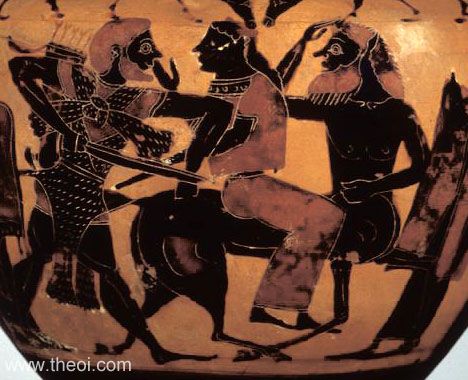
Nessos is trying to grab the Deianeira. Source Theoi com
It is possible that even in Antiquity the thinking people did not believe in the physical existence of such hybrids (Xenophon «Cyrus Education» 4.3.17), perhaps believing the source of the myth to be the bestiality of degenerate animal breeders. Centaurs appear in archaic art as symbols of primitivism, as in contrast to the human heroes carrying proper weapons, the Centaurs attack with tree trunks and rocks. This is also supported by the written sources (Apollodorus 2.3.1).
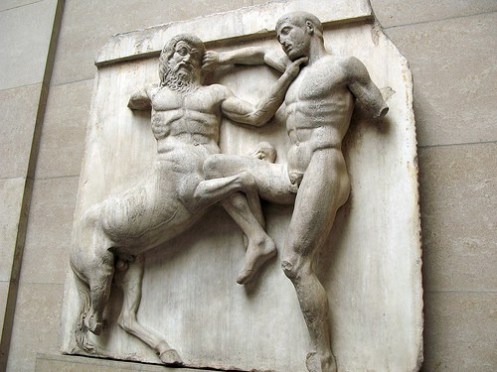
Sculpture depicting Centauromachy from the south side Parthenon. British Museum
The struggle of the people against the hybrid forms of life becomes extremely popular in the sculptural art of the classical period as evidenced by the magnificently made works at the Parthenon pediments and the Apollo’s temple at Vassae of Arcadia. It is only natural as they symbolically portray the prevalence of Greek hoplites against the Asiatic horsearches.
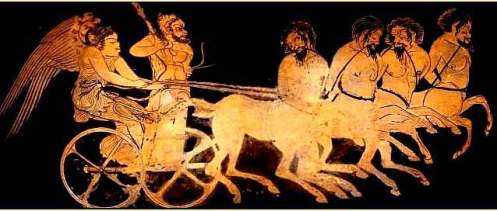
Red-figure pottery from Louvre depicting the opinion of Ancient Greeks about the Centaurs
Centaurs using human weapons appear on the Roman coins of Emperor Galen when the Romans had already developed horse archer units (equites sagittarii). Influenced by Roman iconography, later European artists present Chiron as a horsearcher but also created sculptures with Centaurs lancers or swordsmen. Roman iconography also affected the Easterners as Centaur as an archer appears in the coins of the Turkish dynasty of the Artacides of Mesopotamia in Middle Ages, and judging from their history, they demonstrated all the negative characteristics that the Greeks wanted to symbolize with the myth of the descendants of Ixion
In a strange twist of fate, a » Centauromachy» happened during the Greco-Italian war of 1940 when elements of the 131st Italian «Centauro» armored division, carrying the emblem of the centaur, attempted to break the Greek defense lines at Kalpaki. A 37 mm anti-tank artillery battery, under the command of captain Chailis that crushed the attack, undertook the role of modern Lapiths. Once again, after 2000 years, the descendants of Hercules had crushed the descendants of Ixion.
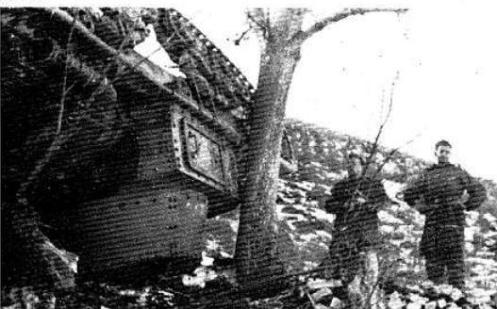
The results of Chailis battery October 1940
If you want to reconstruct hoplites as in the images provided please click here
Sources:
Harvey Nash: The Centaur’s Origin: A Psychological Perspective Author(s) The Classical World, Vol. 77, No. 5 (May – Jun., 1984), pp. 273-291
Frank B. Tarbell: Centauromachy and Amazonomachy in Greek Art: The Reasons for Their Popularity. American Journal of Archaeology. (Jul. – Sep., 1920), pp. 226-231
David Castriota: Myth, Ethos, and Actuality – Official Art in Fifth-century B.C. Athens Univ of Wisconsin Press (1992) pp. 151-155
Mark Stansbury-O’Donnel Looking at Greek Art Cambridge University Press (2011) p. 79
Biers, William. The Archaeology of Greece. United States: Cornell University Press, 1980.
Κωνσταντίνος Τσοπάνης: Περιοδικό Crypto, τεύχος 1, Φεβ. 2005 άρθρο «Κένταυροι, υπήρξαν πραγματικά;»